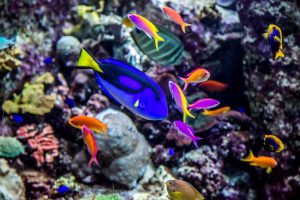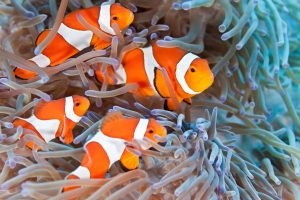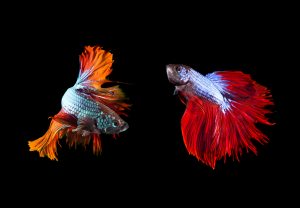Aren’t frogs cute? They’re so fun to watch – moving their little arms and legs as they’re swimming or just floating peacefully like they don’t have a care in the world. A question we hear often is about whether or not you can add a frog to a freshwater fish tank. The answer is, “Sure, but it might be a bit of a challenge.” If you’re up for that challenge, more power to you! Just keep a few things in mind to make sure that frog remains as carefree as can be.
How to Add a Frog to a Freshwater Fish Tank
When adding a frog to a tank, the most important step in general is to avoid shocking it, and tossing it into an unfamiliar environment without the proper preparation would do just that.
 Adding a frog to a freshwater fish tank is similar to adding a new fish to your tank. The basic steps are to first float the bag with the frog in it on top of your existing tank for about 15 minutes in order to bring the water to the same temperature. Afterward, add a cup of the water from the tank into the bag so that the frog becomes more familiar with the water quality. Add another cup about 10 minutes later, until the water in the bag is essentially of the same quality and temperature as the water in the tank. Once your frog is acclimated to the water, use a net to transfer the frog to the tank.
Adding a frog to a freshwater fish tank is similar to adding a new fish to your tank. The basic steps are to first float the bag with the frog in it on top of your existing tank for about 15 minutes in order to bring the water to the same temperature. Afterward, add a cup of the water from the tank into the bag so that the frog becomes more familiar with the water quality. Add another cup about 10 minutes later, until the water in the bag is essentially of the same quality and temperature as the water in the tank. Once your frog is acclimated to the water, use a net to transfer the frog to the tank.
One important factor is the size of the tank. Because a frog is different than the rest of your wildlife, the tank should be big enough that it can find its own space. There just isn’t enough room in a smaller tank for all those different personalities.
Caring for a Frog in a Freshwater Aquarium
As you are choosing a pet frog, talk with your aquarium maintenance technician or a pet shop associate in order to determine the most appropriate breed and to see how large the frog will become when it’s an adult.
An African dwarf frog is the highly preferred choice for a fish tank, as most other types of frogs might eat your fish. Dwarf frogs won’t grow to much larger than about three inches, and you can feed them with the same foods as you do your fish, such as frozen shrimp and bloodworms.
Although owning a frog might be delightful, keep in mind that it has different cleaning and feeding requirements than fish. Fish and frogs also are susceptible to different kinds of diseases, so if one animal gets sick, it could contaminate the tank and make the other inhabitants sick as well.
You should maintain the aquarium habitat according to what’s best for the fish, not the frog, but having a frog in the tank might mean the water and tank itself need to be cleaned more often.
While we’re not discouraging adding a frog into your freshwater aquarium, having a separate tank for the frog might be easier for you, healthier for all your wildlife, and contribute to a more appropriate environment for the frog. You’ll be able to give it the special attention it needs, provide it with more substantial foods, and create a more suitable water quality for the frog. And if it’s in its own tank, you can get just about whatever type of frog you want!







